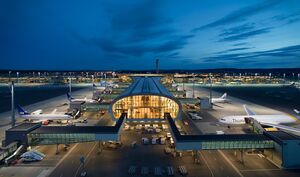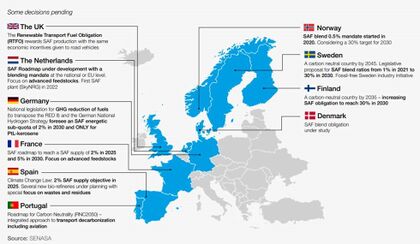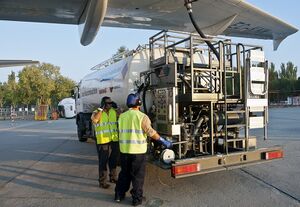وقود حيوي للطيران
وقود حيوي للطيران aviation biofuel أو وقود الطائرات الحيوي bio-jet-fuel[1] أو bio-aviation fuel (BAF)[2]هو وقود حيوي يستخدم لتشغيل الطائرات ويقال أنه وقود طيران مستدام (SAF). يعتبر الاتحاد الدولي للنقل الجوي (IATA) أنه أحد العناصر الرئيسية للحد من بصمة الكربون داخل التأثير البيئي للطيران.[3] يمكن أن يساعد الوقود الحيوي للطيران في إزالة الكربون عن الرحلات الجوية لمسافات طويلة ومتوسطة مما يؤدي إلى توليد معظم الانبعاثات، ويمكن أن يطيل عمر أنواع الطائرات القديمة عن طريق تقليل انبعاثاتها الكربونية.
الوقود الحيوي هو وقود مشتق من الكتلة الحيوية، من النباتات أو النفايات؛ اعتماداً على نوع الكتلة الحيوية المستخدمة، يمكن أن تخفض انبعاثات ثاني أكسيد الكربون بنسبة 20-98٪ مقارنةً بـ وقود الطائرات التقليدي.[4] أول رحلة تجريبية باستخدام الوقود الحيوي المخلوط كانت في عام 2008، وفي عام 2011، تم السماح باستخدام الوقود المخلوط مع 50٪ من الوقود الحيوي في الرحلات الجوية التجارية. في عام 2019، كان الاتحاد الدولي للنقل الجوي يهدف إلى اختراق بنسبة 2٪ بحلول عام 2025.
يمكن إنتاج الوقود الحيوي للطيران من مصادر نباتية مثل اليطروفة والطحالب و الشحم وزيوت النفايات و زيت النخيل و الباباسو و الكاميلينا (bio-SPK); من الكتلة الحيوية الصلبة باستخدام التحلل الحراري المُعالج باستخدام عملية فيشر-تروپش (FT-SPK); باستخدام عملية تحويل الكحول - إلى طائرة (ATJ) من تخمير النفايات; أو من البيولوجيا التركيبية من خلال مفاعل شمسي. ويمكن تعديل المحركات المكبسية الصغيرة لحرق الإيثانول.
لا يتنافس الوقود الحيوي المستدام مع المحاصيل الغذائية أو الأراضي الزراعية أو الغابات الطبيعية أو المياه العذبة. بل هو بديل عن الوقود الاصطناعي.[5] وتم اعتماد وقود الطيران المستدام على أنه مستدام من قبل منظمة خارجية.
التأثير البيئي
تمتص النباتات ثاني أكسيد الكربون أثناء نموها، مما يعني أن الوقود الحيوي النباتي لا يصدر إلا نفس الكمية من غازات الدفيئة التي تم امتصاصها سابقاً. ومع ذلك، فإن إنتاج الوقود الحيوي ومعالجته ونقله ينبعث من غازات الدفيئة مما يقلل من وفورات الانبعاثات.[2] الوقود الحيوي الذي يحقق أكبر قدر من التوفير في الانبعاثات هو الوقود المشتق من طحالب التركيب الضوئي (توفير 98٪، التقنية لم تنضج بعد) ومن المحاصيل غير الغذائية ومخلفات الغابات (توفير 91-95٪).[2]
يجب أن يخفض زيت اليطروفة، وهو زيت غير غذائي يستخدم كوقود حيوي، يجب أن يخفض انبعاثات ثاني أكسيد الكربون بنسبة 50-80٪ مقارنة بـ Jet-A1.[6] يمكن أن تنمو اليطروفة، المستخدمة في الديزل الحيوي، في الأراضي الهامشية حيث تنتج معظم النباتات غلات منخفضة من المحاصيل.[7][8] قدر تقييم دورة الحياة من قبل مدرسة ييل للغابات في اليطروفة، وهو أحد مصادر الوقود الحيوي المحتملة، أن استخدامه يمكن أن يقلل من انبعاثات غازات الاحتباس الحراري بنسبة تصل إلى 85٪ إذا تم استخدام الأراضي الزراعية الرعوية السابقة، أو زيادة الانبعاثات عن طريق تصل إلى 60٪ إذا تم تحويل الغابات الطبيعية للاستخدام.[9]
تتقيد زراعة زيت النخيل بشح موارد الأراضي وتوسعها لتشمل الأراضي الحرجية وإزالة الغابات وفقدان التنوع البيولوجي، والانبعاثات المباشرة وغير المباشرة بسبب تنمية الأراضي.[2]تشتمل منتجات شركة نست المتجددة على تكرير بقايا لزيت النخيل الغذائي، والنفايات الزيتية منزوعة الدسم من مياه الصرف الصحي لمصنع زيت النخيل.[10]تستخدم لوفتهانزا وقود الطيران المستدام لشركة نست.[11]
حددت وكالة ناسا أن 50٪ من خليط الوقود الحيوي للطيران يمكن أن يخفض الانبعاثات الجسيمية التي تسببها الحركة الجوية بنسبة 50-70٪.[12] ولا يحتوي الوقود الحيوي على مركبات الكبريت وبالتالي لا ينبعث منها ثاني أكسيد الكبريت.
Timeline
In 2019, 0.1% of fuel was SAF:[13] the International Air Transport Association (IATA) supports the adoption of Sustainable Aviation fuel, aiming in 2019 for a 2% penetration by 2025: 7 million m3 (1.8 billion US gal).[14] By then, more than 150,000 flights have used biofuels and five airports have regular biofuel distribution: Bergen, Brisbane, Los Angeles, Oslo and Stockholm, with others offering occasional supply.[15]

That year, Virgin Australia had fueled more than 700 flights and flown more than one million kilometers, domestic and international, using Gevo's alcohol-to-jet fuel.[17] Gevo is committed to going after the entire gallon of sustainable aviation fuel, potentially leading to a negative carbon footprint. Virgin Atlantic was working to regularly use fuel derived from the waste gases of steel mills, with LanzaTech.[18] British Airways wanted to convert household waste into jet fuel with Velocys.[18] United Airlines committed to 900 million US gal (3،400،000 m3) of sustainable aviation fuel for 10 years from Fulcrum BioEnergy (to be compared to its 4.1 billion US gal (16،000،000 m3) fuel consumption in 2018), after its $30 million investment in 2015, and will develop up to five biofuel factories near its hubs.[18]
From 2020, Qantas will start using a 50/50 blend of SG Preston’s biofuel on its Los Angeles-Australia flights, also providing fuel derived from non-food plant oils to JetBlue Airways during 10 years.[18] At its sites in Singapore, Rotterdam and Porvoo, Finland's Neste is expecting to improve its renewable fuel production capacity from 2.7 إلى 3.0 million t (6.0 إلى 6.6 billion lb) a year by 2020, and is increasing its Singapore capacity by 1.3 million t (2.9 billion lb) to reach 4.5 million t (9.9 billion lb) in 2022 by investing €1.4 billion ($1.6 billion).[18]
By 2020, International Airlines Group had invested $400 million to convert waste into sustainable aviation fuel with Velocys.[19]
In early 2021, Boeing's CEO Dave Calhoun said drop-in sustainable aviation fuels are "the only answer between now and 2050" to reduce carbon emissions.[20]
Production
Jet fuel is a mixture of a large number of different hydrocarbons. The range of their sizes (molecular weights or carbon numbers) is restricted by the requirements for the product, for example, freezing point or smoke point. Jet fuels are sometimes classified as kerosene or naphtha-type. Kerosene-type fuels include Jet A, Jet A-1, JP-5 and JP-8. Naphtha-type jet fuels, sometimes referred to as "wide-cut" jet fuel, include Jet B and JP-4.
"Drop-in" biofuels are biofuels that are completely interchangeable with conventional fuels. Deriving "drop-in" jet fuel from bio-based sources is ASTM approved via two routes. ASTM has also found it safe to blend in 50% SPK into regular jet fuels.[21][22] Only tests have been done so far with blending in synthetic paraffinic kerosene (SPK) in considerably higher concentrations.[23]
- HEFA-SPK
This section requires expansion. (December 2020) |
- Hydroprocessed Esters and Fatty Acids Synthetic Paraffinic Kerosine (HEFA-SPK) is a specific type of hydrotreated vegetable oil fuel used in aviation.[2] اعتبارا من 2020[تحديث] this is the only mature technology.[15][2] HEFA-SPK fuel is considered as leading alternative replacements for conventional jet fuel by the CAA because of its sustainability.[24] HEFA-SPK was approved by Altair Engineering for use in 2011.[25] HEFA-SPK is produced by the deoxygenation and hydroprocessing of the feedstock fatty acids of algae, jatropha, and camelina.[26]
- Bio-SPK
- This route involves using oil which is extracted from plant sources like Jatropha, algae, tallows, other waste oils, Babassu and Camelina to produce bio derived synthetic paraffinic kerosene (bio-SPK) by cracking and hydroprocessing. The growing of algae to make jet fuel is a promising but still emerging technology. Companies working on algae jet fuel are Solazyme, Honeywell UOP, Solena, Sapphire Energy, Imperium Renewables, and Aquaflow Bionomic Corporation. Universities working on algae jet fuel are Arizona State University and Cranfield University Major investors for algae based SPK research are Boeing, Honeywell/UOP, Air New Zealand, Continental Airlines, Japan Airlines, and General Electric.
- FT-SPK
- The second route involves processing solid biomass using pyrolysis to produce pyrolysis oil or gasification to produce a syngas which is then processed into FT SPK (Fischer–Tropsch Synthetic Paraffinic Kerosene).
- ATJ-SPK
- Research is also being done on the alcohol-to-jet (ATJ) pathway where alcohols such as ethanol or butanol are de-oxygenated and processed into jet fuels.[27] Some companies such as LanzaTech have already managed to create ATJ-SPK from CO2 in flue gases.[28] The ethanol is hereby produced from CO in the flue gases using microbes (clostridium autoethanogenum to be exact). LanzaTech has successfully demonstrated its technology at Pilot scale in NZ –using Industrial waste gases from the steel industry as a feedstock for its microbial fermentation.[29][30][31]
- Future production routes
- Routes that use synthetic biology to directly create hydro-carbons are being researched. Also, the production of Fischer-Tropsch hydro-carbon fuels (i.e. FT-SPK, referred to as "solar kerosine" by the project) through the use of a solar reactor is being researched by the SUN-TO-LIQUID project.[32][33][34]
- Piston engines
- Small piston engines can be modified to burn ethanol as a fuel.[35] Swift Fuel, a biofuel alternative to avgas under development, was approved as a test fuel by ASTM International in December 2009, aiming for a comparably priced, environmentally friendlier and more fuel-efficient general aviation fuel.[36][37]
Technical challenges
Nitrile-based rubber materials expand in the presence of aromatic compounds found in conventional petroleum fuel. Pure biofuels that aren't mixed with petroleum and don't contain paraffin-based additives may cause rubber seals and hoses to shrink.[38] Manufacturers are starting[needs update] to use synthetic rubber substitutes which are not adversely affected by biofuels, such as Viton, for seals and hoses.[39] The United States Air Force has found harmful bacteria and fungi in their biofueled aircraft, and use pasteurization to disinfect them.[40]
Economics
The International Energy Agency forecast SAF production should grow from 18 to 75 billion litres between 2025 and 2040, representing a share of aviation fuel getting from 5% to 19%.[15] By 2019, fossil jet fuel production cost was $0.3-0.6 per L given a $50–100 crude oil barrel, while aviation biofuel production cost was $0.7-1.6, needing a $110–260 crude oil barrel to break-even.[15]
اعتبارا من 2020[تحديث] aviation biofuel is more expensive than fossil jet kerosene,[1] considering aviation taxation and subsidies at that time.[41]
Sustainable fuels

Sustainable biofuels do not compete with food crops, prime agricultural land or fresh water. Sustainable aviation fuel (SAF) are certified as being sustainable by a third-party like the Roundtable For Sustainable Biofuels. The sustainable aviation fuels certification and production pace seems insufficient to meet the International Air Transport Association target of halving the CO₂ emissions by 2050.[42]
While not biofuels, hydrogen combusted directly or used in a fuel cell, and electrical propulsion using rechargeable batteries are also sustainable.
Certification
A SAF sustainability certification verifies that the fuel product, mainly focussing on the biomass feedstock, has met criteria focussed around long-term global environmental, social and economic "triple-bottom-line" sustainability considerations. Under many carbon emission regulation schemes, such as the European Union Emissions Trading Scheme, a certified SAF product may be granted an exemption from an associated carbon compliance liability cost.[43] This marginally improves the economic competitiveness of environmentally favourable SAF over traditional fossil-based jet fuel. However, in the near term there are several commercialisation and regulatory hurdles that are yet to be overcome through the collaboration of a variety of stakeholders for SAF products to meet price parity with traditional jet fuel and to enable widespread uptake.[44]
The first reputable body to launch a sustainable biofuel certification system applicable to SAF was the academic European-based Roundtable on Sustainable Biomaterials (RSB) NGO.[45] This multi-stakeholder organization set a global benchmark standard on which the sustainability integrity of advanced aviation biofuel types seeking to use the claim of being a Sustainable Aviation Fuel can be judged. Leading airlines in the aviation industry and other signatories to the Sustainable Aviation Fuel Users Group (SAFUG) pledge support the RSB as the preferred provider of SAF certification.[46] These airlines believe it important for any proposed aviation biofuels have independently certified sustainable biofuel long term environmental benefits compared to the status quo in order to ensure their successful uptake and marketability[47]
Sustainability criteria
- EU RED II Recast (2018)
- GHG reduction - Greenhouse gas emissions from aviation sustainable fuels must be lower than those from the fossil fuels they replace: at least 50% for production facilities prior to 5 October 2015, a mandatory reduction of 60% for production facilities after that date and 65% for sustainable fuels (SAF) produced in facilities starting operations after 2021.
- Land use change - Carbon stocks and biodiversity: raw materials for sustainable fuel production cannot be sourced from land with high biodiversity or high carbon stocks (i.e. primary and protected forests, biodiversity-rich grasslands, wetlands and peatlands).
- Other sustainability issues are set out in the Governance Regulation and may be covered by certification schemes on a voluntary basis.
- ICAO ‘CORSIA’
- GHG Reduction - Criterion 1: Sustainable alternative fuel for reactors will generate net GHG reductions of at least 10% compared to fossil fuel for reactors, based on the life cycle.
- Carbon Stock - Criterion 1: Sustainable alternative Fuel will not be produced from biomass obtained from land whose uses changed after 1st January 2008 and which has been from primeval forests, wetlands or peatlands, as all these lands have high carbon stocks. Criterion 2: In the case of a change in land use after 1st January 2008, as defined on the basis of the IPCC land categories, emissions from direct land use change (DLUC) shall be calculated. If the greenhouse gas emissions from a DLUC exceed the default value of the land use change induced (ILUC), the value of the DLUC will replace the default value of the ILUC.
Global impact

As emissions trading schemes and other carbon compliance regimes are emerging globally, certain biofuels are likely to be exempted ("zero rated") by governments from having an associated carbon compliance liability due to their closed-emissions-loop renewable nature, if they can also prove their wider sustainability credentials. For example, in the European Union Emissions Trading Scheme it has been proposed by SAFUG that only aviation biofuels that have been certified as sustainable by the RSB or similar bodies would be zero rated.[49] This proposal has been accepted.[50] SAFUG was formed by a group of interested airlines in 2008 under the auspices of Boeing Commercial Airplanes and in cooperation with support from NGOs such as Natural Resources Defense Council. Member airlines represent more than 15% of the industry, and all member CEOs have signed a pledge to work on the development and use of Sustainable Aviation Fuel.[51][52]
In addition to SAF certification, the integrity of aviation biofuel producers and their product can be assessed by further means, such as by using Richard Branson's Carbon War Room,[53] or the Renewable Jet Fuels initiative.[54] The latter currently cooperates with companies such as LanzaTech, SG Biofuels, AltAir, Solazyme, and Sapphire. A leading independent NGO focused on this issue is the Sustainable Sky Institute.[55]
Certified processes
| Abbreviation | Conversion Process | Possible Feedstocks | Blending Ratio | Commercialization Proposals / Projects |
|---|---|---|---|---|
| HEFA-SPK | Synthesized paraffinic kerosene produced from hydroprocessed esters and fatty acids | Bio-Oils, Animal Fat, Recycled Oils | 50% | World Energy, Universal Oil Products, Neste, Dynamic Fuels, EERC |
| FT-SPK | Fischer-Tropsch hydroprocessed synthesized paraffinic kerosene | Coal, Natural Gas, Biomass | 50% | Fulcrum Bioenergy, Red Rock Biofuels, SG Preston, Kaidi Finland, Sasol, Shell Oil Company, Syntroleum |
| SIP-HFS | Synthesized kerosene isoparaffins produced from hydroprocessed fermented sugars | Biomass used for sugar production | 10% | Amyris (company), Total S.A. |
| SPK/A | Synthesized kerosene with aromatics derived by alkylation of light aromatics from non-petroleum sources | Coal, Natural Gas, Biomass | 50% | Sasol |
| ATJ-SPK | Alcohol-to-jet synthetic paraffinic kerosene | Biomass from ethanol or isobutanol production | 50% | Gevo, Cobalt, Universal Oil Products, Lanzatech, Swedish Biofuels, Byogy |
انظر أيضاً
الهامش
- ^ أ ب "Sustainable aviation fuel market demand drives new product launches". Investable Universe (in الإنجليزية الأمريكية). 2020-12-04.
- ^ أ ب ت ث ج ح Doliente, Stephen S.; et al. (10 July 2020). "Bio-aviation Fuel: A Comprehensive Review and Analysis of the Supply Chain Components". Frontiers in Energy Research (in English). 8. doi:10.3389/fenrg.2020.00110.
{{cite journal}}: CS1 maint: unrecognized language (link) - ^ "Developing Sustainable Aviation Fuel (SAF)". IATA.
- ^ Bauen, Ausilio (August 2009). Review of the potential for biofuels in aviation. E4tech. Archived from the original. You must specify the date the archive was made using the
|archivedate=parameter. http://citeseerx.ist.psu.edu/viewdoc/download?doi=10.1.1.170.8750&rep=rep1&type=pdf. - ^ Mark Pilling (2021-03-25). "How sustainable fuel will help power aviation's green revolution". Flight Global.
- ^ "A Greener Future?". Aircraft Illustrated. March 2009.
- ^ Ron Oxburgh (28 February 2008). "Through biofuels we can reap the fruits of our labours". The Guardian.
- ^ Patrick Barta (24 March 2008). "As Biofuels Catch On, Next Task Is to Deal With Environmental, Economic Impact". Wall Street Journal.
- ^ Bailis, R. E.; Baka, J. E. (2010). "Greenhouse Gas Emissions and Land Use Change from Jatropha Curcas-Based Jet Fuel in Brazil". Environmental Science & Technology. 44 (22): 8684–91. Bibcode:2010EnST...44.8684B. doi:10.1021/es1019178. PMID 20977266.
- ^ "Waste and residues as raw materials". Neste. 15 May 2020.
- ^ "Neste and Lufthansa collaborate and aim for a more sustainable aviation" (Press release). Neste. October 2, 2019.
- ^ "NASA confirms biofuels reduce jet emissions". Flying Mag. March 23, 2017.
- ^ 2021-03-25T14:13:00+00:00. "How sustainable fuel will help power aviation's green revolution". Flight Global (in الإنجليزية). Retrieved 2021-03-28.
{{cite web}}: CS1 maint: numeric names: authors list (link) - ^ "Sustainable Aviation Fuels Fact sheet" (PDF). IATA. May 2019.
- ^ أ ب ت ث Pharoah Le Feuvre (18 March 2019). "Are aviation biofuels ready for take off?". International Energy Agency.
- ^ "Expanding our commitment to powering more flights with biofuel" (Press release). United Airlines. May 22, 2019.
- ^ "Virgin Australia's sustainable aviation fuel flies one million kilometres" (Press release). Virgin Australia. 17 June 2019.
- ^ أ ب ت ث ج Kerry Reals (Apr 26, 2019). "Biofuel Market Is Nearing A Tipping Point". Aviation Week & Space Technology.
- ^ "BA begins offsetting domestic flight emissions". Flightglobal. 3 January 2020.
- ^ Guy Norris (February 4, 2021). "Boeing Moves Forward With Airbus A321XLR-Competitor Plan". Aviation Week.
- ^ "Standard Specification for Aviation Turbine Fuel Containing Synthesized Hydrocarbons".
- ^ خطأ استشهاد: وسم
<ref>غير صحيح؛ لا نص تم توفيره للمراجع المسماةASTMsep2011 - ^ Snijders, T. A.; Melkert, J. A. (December 22, 2011). "Evaluation of safety, performance and emissions of synthetic fuel blends in a Cessna Citation II". Conference Proceeedings of the 3AF/AIAA Aircraft Noise and Emissions Reduction Symposium, 25–27 October 2011, Marseille, France – via repository.tudelft.nl.
- ^ https://ogst.ifpenergiesnouvelles.fr/articles/ogst/pdf/2016/01/ogst120241.pdf
- ^ https://www.etipbioenergy.eu/images/ETIP_Bioenergy_Factsheet_Aviation_Biofuels.pdf
- ^ "Producing sustainable aviation fuel".
- ^ "ATJ-SPK (Alcohol to Jet Synthetic Paraffinic Kerosene) – Advanced BioFuels USA".
- ^ "Jet Fuel Derived from Ethanol Now Eligible for Commercial Flights".
- ^ Voegele, E. November 2009. “Waste to ethanol projects move forward”, Ethanol Producer Magazine
- ^ "Interview: LanzaTech CEO Jennifer Holmgren". www.triplepundit.com.
- ^ Nagaraju, Shilpa; Davies, Naomi Kathleen; Walker, David Jeffrey Fraser; Köpke, Michael; Simpson, Séan Dennis (October 18, 2016). "Genome editing of Clostridium autoethanogenum using CRISPR/Cas9". Biotechnology for Biofuels. 9 (1): 219. doi:10.1186/s13068-016-0638-3. PMC 5069954. PMID 27777621.
{{cite journal}}: CS1 maint: unflagged free DOI (link) - ^ SOLAR-JET project terminated and succeeded by SUN-TO-LIQUID project
- ^ "Press corner". European Commission - European Commission.
- ^ "SUN to LIQUID project - SUN to LIQUID project". www.sun-to-liquid.eu.
- ^ "AGE-85 (Aviation Grade Ethanol)". South Dakota State University. 2006. Archived from the original on 2008-05-15.
- ^ "Indiana Airline Fuel Developer Moves Ahead With Testing" (Press release). Purdue Research Park. December 14, 2009.
- ^ Grady, Mary (December 15, 2009). "Efforts Move Forward To Produce Alternative Aviation Fuels".
- ^ "Technical Report: Near-Term Feasibility of Alternative Jet Fuels" (PDF). Sponsored by the FAA. Authored by MIT staff. Published by RAND Corporation. Retrieved August 22, 2012.
- ^ "Biodiesel FAQ" (PDF). University of Kentucky College of Agriculture, Food, and Environment. 2006. Retrieved August 22, 2012.
- ^ "AFRL discovering what's "bugging" military aircraft". U.S. Air Force.
- ^ "Sustainable Aviation Fuel: Review of Technical Pathways" (PDF). United States Department of Energy. Sep 2020.
- ^ Kerry Reals (Oct 10, 2017). "Glacial Pace Of Advancements In Biofuel Threatens Emissions Targets". Aviation Week & Space Technology.
- ^ "Sustainability schemes for biofuels". European Commission/Energy/Renewable energy/Biofuels. Retrieved 1 April 2012.
- ^ "Sustainable Aviation Fuel". Qantas. Retrieved 2013-10-24.
- ^ "RSB Roundtable on Sustainable Biomaterials | Roundtable on Sustainable Biomaterials" (PDF). Rsb.epfl.ch. 2013-10-17. Archived from the original (PDF) on 2011-12-22. Retrieved 2013-10-24.
- ^ "Our Commitment to Sustainable Options". Archived from the original on April 25, 2012. Retrieved March 29, 2012.
- ^ "Sustainable Aviation Fuel Users Group – SAFUG". Safug.org. Retrieved 2013-10-24.
- ^ Clean Skies for Tomorrow: Sustainable Aviation Fuels as a Pathway to Net-Zero Aviation (PDF) (in الإنجليزية). World Economic Forum. 2020-11-11.
{{cite book}}: Unknown parameter|lay-date=ignored (help); Unknown parameter|lay-url=ignored (help) - ^ "Sustainable Aviation Fuel Users Group : European Section" (PDF). Safug.org. Retrieved 2013-10-24.
- ^ "Revision of the EU Energy Tax Directive - technical press briefing" (PDF). Ec.europa.eu. Retrieved 2013-10-24.
- ^ "Environment and Biofuels | Boeing Commercial Airplanes". Boeing.com. Retrieved 2013-10-24.
- ^ "SAFUG Pledge; Boeing Commercial Airplanes". safug.org. Retrieved 2015-07-10.
- ^ "Renewable Jet Fuels". Carbon War Room. Archived from the original on 2013-10-30. Retrieved 2013-10-24.
- ^ "Welcome". Renewable Jet Fuels. Archived from the original on 2013-10-29. Retrieved 2013-10-24.
- ^ "Sustainable Sky Institute". Sustainable Sky Institute. Retrieved 2016-04-26.
للاستزادة
- Adam Klauber and Isaac Toussie (Rocky Mountain Institute), Steve Csonka (Commercial Aviation Alternative Fuels Initiative), Barbara Bramble (National Wildlife Federation) (Oct 23, 2017). "Opinion: Biofuels Sustainable, Essential To Aviation's Future". Aviation Week & Space Technology.
{{cite news}}: CS1 maint: multiple names: authors list (link) - "Sustainable Aviation Fuel" (PDF). Gevo. December 2019.
Alcohol-to-Jet Synthetic Paraffinic Kerosene Is a Proven Pathway to Deliver a Bio-Based, Low-Carbon Option to Travelers
External links
- "Sustainable Sky Institute".
non-profit think tank/do tank focussed on [...] the market transformation of the world's air transport system towards a [...] sustainable long-term future
- "Aviation industry reducing its environmental footprint". Aviation: Benefits Beyond Borders. Air Transport Action Group.
- Air travel, climate change, and green consumerism, Appropedia
- "Nordic Initiative for Sustainable Aviation".
Nordic association working to promote and develop a more sustainable aviation industry, with a specific focus on alternative sustainable fuels
- "Roundtable on Sustainable Biofuels".
The RSB is supporting the development of a sustainable bioeconomy
- "International Journal of Sustainable Aviation". Inderscience Publishers.
- "Biofuels for aviation". European Commission.
- Geoff Hunt (22 April 2021). "Why industry needs global standards for sustainable fuel use". Flightglobal.
- CS1 الإنجليزية الأمريكية-language sources (en-us)
- CS1 maint: numeric names: authors list
- CS1 maint: unflagged free DOI
- CS1 errors: unsupported parameter
- Articles with hatnote templates targeting a nonexistent page
- Articles to be expanded from December 2020
- All articles to be expanded
- مقالات فيها عبارات متقادمة منذ 2020
- جميع المقالات التي فيها عبارات متقادمة
- Wikipedia articles in need of updating from December 2020
- All Wikipedia articles in need of updating
- Algae biofuels
- Aviation and the environment
- Aviation fuels
- Biofuels
